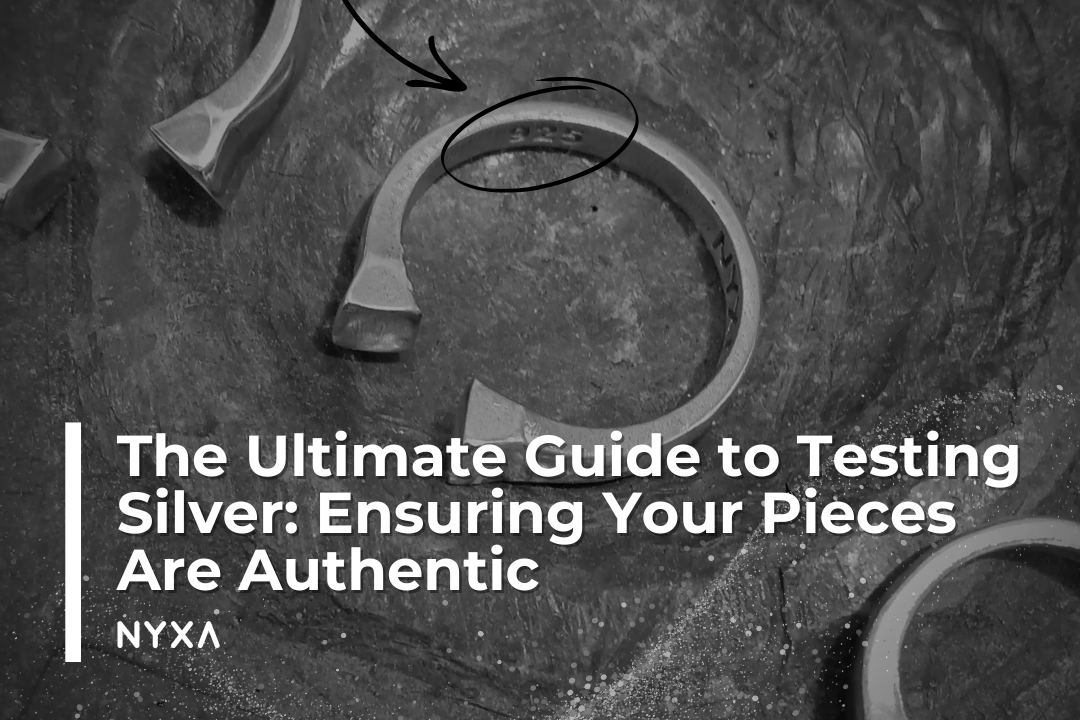
The Ultimate Guide to Testing Silver: Ensuring Your Pieces Are Authentic
Share
Why Authentic Silver Matters
Silver is more than just metal—it’s a future artifact, a connection to history, and a reflection of craftsmanship. But with so many lookalikes flooding the market, do you know how to tell if silver is real? Here’s what you need to check before you buy—or worse, get fooled.
Whether you’re investing in quality jewelry or preserving a meaningful piece, knowing how to test silver is essential. Here’s everything you need to spot real silver, from quick at-home tests to advanced authentication methods.
How to Tell If Silver Is Real: Key Visual Indicators
Before learning how to test silver with DIY methods, start with a close inspection. Knowing how to tell if silver is real begins with key visual indicators—distinct markings, oxidation patterns, and the way silver interacts with light.
1. Check for a Hallmark Stamp
Most authentic silver jewelry and accessories are marked with a stamp indicating purity. Look for:
✔ "925" – This means the piece is 92.5% pure silver, also known as sterling silver.
✔ "Sterling" or "Ster" – Another way to mark genuine sterling silver.
✔ "999" – Found on fine silver, which is 99.9% pure silver.
⚠ Warning: Fake silver may have similar stamps, so use other tests to confirm authenticity.
2. Look for Tarnish—Yes, Really!
Real silver oxidizes over time, meaning it develops a dark patina when exposed to air and moisture. If your piece looks too perfect and never tarnishes, it might be silver-plated or an imitation metal.
3. Spot the Difference Between Silver-Plated & Solid Silver
Silver-plated jewelry has only a thin layer of silver over a base metal (like copper or brass). Over time, plating wears off, exposing the metal beneath. A real sterling silver piece, however, will always be silver through and through.
How to Test Silver at Home: DIY Methods for Authenticity
If you’re still unsure, try these simple at-home tests to check your silver’s authenticity.
1. How to Test Silver with Ice: The Thermal Conductivity Method
Wondering how to test silver at home? The ice test is one of the easiest methods. Silver has the highest thermal conductivity of any metal, meaning an ice cube will melt much faster on real silver than on a fake piece.
✔ Place an ice cube on your silver piece and another on a non-silver surface.
✔ If it’s real silver, the ice cube will melt significantly faster than the one on the other surface.
2. Is Silver Magnetic? How to Test Silver with a Magnet
If you want to know how to tell if silver is real without damaging it, try the magnet test. Authentic silver is not magnetic, so if your piece sticks to a magnet, it’s likely not real silver.
✔ Hold a strong magnet (like a neodymium magnet) near your jewelry.
✔ If it sticks, your piece contains another metal—not real silver.
✔ If it doesn’t stick, it could be authentic—but this test alone isn’t foolproof.
3. How to Tell If Silver Is Real with the Tarnish Test
Silver reacts to air and moisture over time, forming a black or gray tarnish.
✔ Gently rub a small, soft white cloth on the silver.
✔ If black marks appear, that’s a good sign—it’s likely real silver!
✔ If there’s no discoloration, it might be plated or fake.
4. Can You Smell Fake Silver? How to Test Silver with the Odor Test
Silver doesn’t have a strong smell. If your jewelry smells like pennies or metallic, it may contain too much copper, meaning it’s not real silver.
Advanced Silver Testing Methods
For high-value or sentimental pieces, consider professional tests for accuracy.
1. How to Test Silver with an Acid Kit: A Step-by-Step Guide
A silver acid test kit uses nitric acid to reveal silver purity.
✔ Apply a small drop of silver testing acid to your piece.
✔ If it turns red or brown, it’s likely sterling silver.
✔ If it turns green, it contains base metals.
⚠ Caution: This test can damage jewelry, so use it sparingly.
2. Professional Appraisal
If you’re still unsure, take your piece to a trusted jeweler who can conduct professional tests using X-ray fluorescence or density measurements.
How to Maintain Real Silver: Storage, Cleaning, & Preservation
Now that you know your piece is authentic, here’s how to keep it looking flawless:
✔ Store it properly – Keep silver in anti-tarnish pouches or a sealed bag to prevent oxidation.
✔ Polish regularly – Use a soft silver polishing cloth to remove tarnish.
✔ Keep it dry – Avoid wearing silver in water or exposing it to harsh chemicals (like perfume and chlorine).
At NYXA, we believe jewelry should be more than an accessory—it should be a future artifact, something that carries your story as it ages. That’s why we work exclusively with high-quality sterling silver designed to evolve beautifully over time. Silver, like all things, transforms. It oxidizes, deepens, and takes on a patina—a living reflection of time itself. That’s the beauty of authenticity: it evolves with you, rather than wearing away like a false veneer.
Why Investing in Authentic Silver is Worth It
Buying real silver isn’t just about quality—it’s about craftsmanship, sustainability, and history. A genuine silver ring or necklace isn’t something you toss after a few wears—it’s a future artifact, something to be passed down, a piece of your personal story preserved in metal.
At NYXA, we believe in timeless jewelry that lasts—pieces that aren’t just accessories, but symbols of self-expression, resilience, and artistry.
Shop NYXA’s handcrafted sterling silver jewelry—because the best pieces aren’t just beautiful, they’re real.



